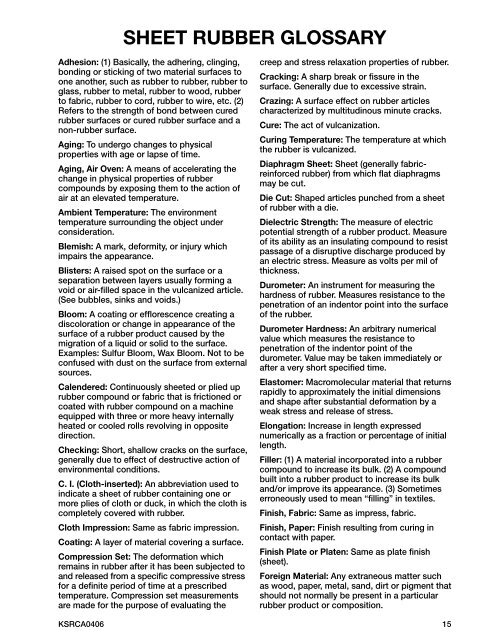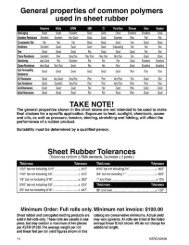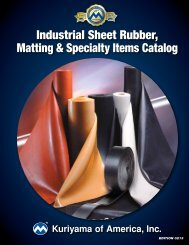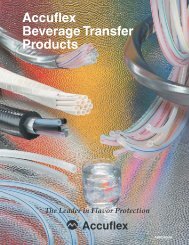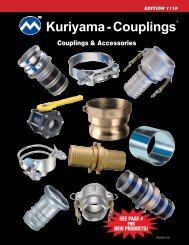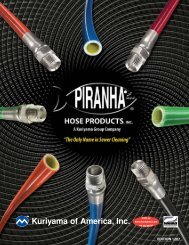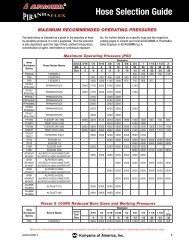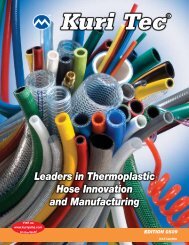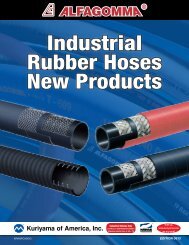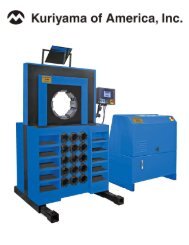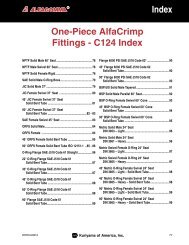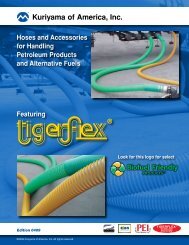specifications - Kuriyama of America
specifications - Kuriyama of America
specifications - Kuriyama of America
You also want an ePaper? Increase the reach of your titles
YUMPU automatically turns print PDFs into web optimized ePapers that Google loves.
SHEET RUBBER GLOSSARY<br />
Adhesion: (1) Basically, the adhering, clinging,<br />
bonding or sticking <strong>of</strong> two material surfaces to<br />
one another, such as rubber to rubber, rubber to<br />
glass, rubber to metal, rubber to wood, rubber<br />
to fabric, rubber to cord, rubber to wire, etc. (2)<br />
Refers to the strength <strong>of</strong> bond between cured<br />
rubber surfaces or cured rubber surface and a<br />
non-rubber surface.<br />
Aging: To undergo changes to physical<br />
properties with age or lapse <strong>of</strong> time.<br />
Aging, Air Oven: A means <strong>of</strong> accelerating the<br />
change in physical properties <strong>of</strong> rubber<br />
compounds by exposing them to the action <strong>of</strong><br />
air at an elevated temperature.<br />
Ambient Temperature: The environment<br />
temperature surrounding the object under<br />
consideration.<br />
Blemish: A mark, deformity, or injury which<br />
impairs the appearance.<br />
Blisters: A raised spot on the surface or a<br />
separation between layers usually forming a<br />
void or air-filled space in the vulcanized article.<br />
(See bubbles, sinks and voids.)<br />
Bloom: A coating or efflorescence creating a<br />
discoloration or change in appearance <strong>of</strong> the<br />
surface <strong>of</strong> a rubber product caused by the<br />
migration <strong>of</strong> a liquid or solid to the surface.<br />
Examples: Sulfur Bloom, Wax Bloom. Not to be<br />
confused with dust on the surface from external<br />
sources.<br />
Calendered: Continuously sheeted or plied up<br />
rubber compound or fabric that is frictioned or<br />
coated with rubber compound on a machine<br />
equipped with three or more heavy internally<br />
heated or cooled rolls revolving in opposite<br />
direction.<br />
Checking: Short, shallow cracks on the surface,<br />
generally due to effect <strong>of</strong> destructive action <strong>of</strong><br />
environmental conditions.<br />
C. I. (Cloth-inserted): An abbreviation used to<br />
indicate a sheet <strong>of</strong> rubber containing one or<br />
more plies <strong>of</strong> cloth or duck, in which the cloth is<br />
completely covered with rubber.<br />
Cloth Impression: Same as fabric impression.<br />
Coating: A layer <strong>of</strong> material covering a surface.<br />
Compression Set: The deformation which<br />
remains in rubber after it has been subjected to<br />
and released from a specific compressive stress<br />
for a definite period <strong>of</strong> time at a prescribed<br />
temperature. Compression set measurements<br />
are made for the purpose <strong>of</strong> evaluating the<br />
creep and stress relaxation properties <strong>of</strong> rubber.<br />
Cracking: A sharp break or fissure in the<br />
surface. Generally due to excessive strain.<br />
Crazing: A surface effect on rubber articles<br />
characterized by multitudinous minute cracks.<br />
Cure: The act <strong>of</strong> vulcanization.<br />
Curing Temperature: The temperature at which<br />
the rubber is vulcanized.<br />
Diaphragm Sheet: Sheet (generally fabricreinforced<br />
rubber) from which flat diaphragms<br />
may be cut.<br />
Die Cut: Shaped articles punched from a sheet<br />
<strong>of</strong> rubber with a die.<br />
Dielectric Strength: The measure <strong>of</strong> electric<br />
potential strength <strong>of</strong> a rubber product. Measure<br />
<strong>of</strong> its ability as an insulating compound to resist<br />
passage <strong>of</strong> a disruptive discharge produced by<br />
an electric stress. Measure as volts per mil <strong>of</strong><br />
thickness.<br />
Durometer: An instrument for measuring the<br />
hardness <strong>of</strong> rubber. Measures resistance to the<br />
penetration <strong>of</strong> an indentor point into the surface<br />
<strong>of</strong> the rubber.<br />
Durometer Hardness: An arbitrary numerical<br />
value which measures the resistance to<br />
penetration <strong>of</strong> the indentor point <strong>of</strong> the<br />
durometer. Value may be taken immediately or<br />
after a very short specified time.<br />
Elastomer: Macromolecular material that returns<br />
rapidly to approximately the initial dimensions<br />
and shape after substantial deformation by a<br />
weak stress and release <strong>of</strong> stress.<br />
Elongation: Increase in length expressed<br />
numerically as a fraction or percentage <strong>of</strong> initial<br />
length.<br />
Filler: (1) A material incorporated into a rubber<br />
compound to increase its bulk. (2) A compound<br />
built into a rubber product to increase its bulk<br />
and/or improve its appearance. (3) Sometimes<br />
erroneously used to mean “filling” in textiles.<br />
Finish, Fabric: Same as impress, fabric.<br />
Finish, Paper: Finish resulting from curing in<br />
contact with paper.<br />
Finish Plate or Platen: Same as plate finish<br />
(sheet).<br />
Foreign Material: Any extraneous matter such<br />
as wood, paper, metal, sand, dirt or pigment that<br />
should not normally be present in a particular<br />
rubber product or composition.<br />
KSRCA0406 15


